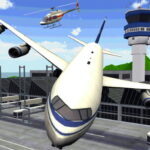Flying Games That Let You Master the Skies with Precision, Speed, and Exploration 🛫
Flying games are airborne adventures that give players control of aircraft, helicopters, drones, and even fantastical flying machines. These games span a wide spectrum—from hyper-realistic simulators built on real-world physics to fast-paced arcade titles that prioritize aerial stunts and combat. This genre caters to anyone drawn to the freedom and skill required to stay airborne, from cruising through the stratosphere to diving into dogfights.
Flying games have steadily evolved into sophisticated experiences that now include real-world mapping, weather simulation, and advanced aerodynamics. They now share space with driving games, shooting games, and simulator games, forming a versatile genre that appeals to casual players and simulation enthusiasts alike.
🧠 Why Flying Games Offer More Than Just Air Time
Flying games engage the senses and challenge reflexes in ways few other genres can. Their appeal lies in the balance between control and chaos, speed and stillness, realism and escapism. Key elements that define the genre include:
- 🕹️ Diverse Flight Controls: Games may support keyboard, joystick, touch, or full HOTAS systems, scaling from beginner-friendly to pro-grade setups.
- 🌍 Expansive Environments: Open skies, mountain ranges, or sci-fi space maps encourage exploration and test aerial maneuvering.
- 💣 Aerial Combat Mechanics: In combat sub-genres, players lock onto enemies, dodge missiles, and manage limited ammo during mid-air skirmishes.
- 🎯 Mission-Based Objectives: Tasks may include air deliveries, air races, firefighting, dogfighting, or timed landings.
- 🚁 Custom Aircraft and Upgrades: Many games allow modification of planes, jets, or flying creatures for speed, handling, or firepower.
🧩 Flying Games for Every Type of Pilot
This genre adapts well to a variety of player preferences:
- Simulation fans often gravitate toward Microsoft Flight Simulator or X-Plane, which offer real-world routes, weather systems, and pilot-grade realism.
- Arcade players enjoy titles like Sky Force Reloaded or After Burner, known for their accessible controls and vibrant designs.
- Combat lovers prefer Ace Combat or War Thunder, where reflexes and tactics dominate the skies.
- Mobile users explore lighter airplane games and drone simulators, often optimized for short sessions and touchscreen input.
Flying games often overlap with action games, military games, and VR games, making them suitable for varied topical SEO strategies and internal content linking.
From the rise of drone simulators to global open-world maps powered by satellite data, the genre continues to evolve. Advances in cloud computing, VR immersion, and control hardware have helped flying games retain relevance even in a fast-moving gaming landscape.
Games now cater to casual flyers, competitive pilots, and real-world aviation students alike. Many titles even allow players to simulate emergency landings, fly commercial routes, or recreate historical aerial battles—all while sitting at a desk.















































































